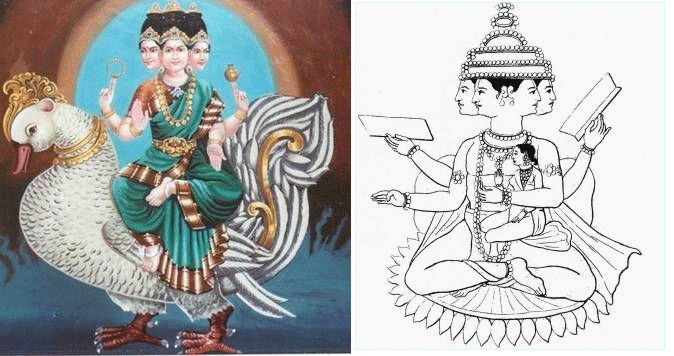BRAHMA

Image on left used with permission. Image on right from Moor.
Basic Description: Known as the "Creator," Brahma is frequently allied with Vishnu, the "Preserver," and Shiva, the "Destroyer," to compose the Hindu trinity, the "trimurti." In general, Brahma is the deity who created the universe. After the world has gone through a complete cycle of existence, it will be destroyed by Shiva, and Brahma will create a new one, which will move through the same cycle again. Brahma has the first of three attributes of the Brahm; he is the supreme being. He is also the oldest of the gods. Please be aware of the difference between Brahma, the Creator, and Brahman, the ultimate world soul. The latter, which is an impersonal reality, is the focus of the more mystical monistic forms of Hinduism. Alternate Names: Prajapati, Ishavara, Pitamaha, Kamalasana, Atmabhu, Paramesti, Hiranyagarbha, Savitripathi, Adikavi, Bhraspati, Adi-Kavi, Vidhi, Sastr, Dhar, Sanat, Lokesha, Dru-Ghana, Kamalayoni. History/Practices: Brahma emerged out of the history of early Hinduism as the deity who subsumed various creation myths. For a time he apparently had a large following of devotees; however, although he is still worshiped today, he is not usually the central deity of temples, with the exception of one temple in Pushkar in Ajmer. Iconography: Brahma's most distinctive feature is the fact that he is shown with four heads (or faces). Where color matters, he is depicted as red or pink. Three of the most common items in his hands are a string of pearls, a water jug, or the Vedas. Mythology: The following are some of the central myths concering Brahma: Brahma's birth: He emerged out of either a lotus blossom or a golden embryo. Shiva Birth Myth: Brahma and Vishnu were born first, they were alone together arguingabout who was the most powerful. Suddenly before them appeared a lingam. The lingam went up as far as they could see and down as far as theycould see. Together they decided to tryand explore it. Vishnu became a boar andtraveled down for a thousand years, but never found a base. Brahma became a goose and traveled up for athousand years, but never found a top. They both returned to where they had started and the lingam became Shiva, thus proving that Shiva was the most powerful. Brahma's heads: After Brahma had given birth to his consort Sarasvati, he wished to get a good look at her beauty, but she did not want to put up with his stares. She kept dodging his glances--to one side, to another, behind him, above him in heaven. However, each time, Brahma grew another head with another pair of eyes, so that she could not escape his line of sight. Subsequently, Brahma had an encounter with Shiva. There are many different versions of this meeting, most of them either state that Brahma thought he was superior to Shiva or report that Shiva rebuked Brahma for alleged incestuous behavior. Regardless of the context, the stories agree that Shiva opened his "third eye" and immediately incinerated one of Brahma's heads into oblivion. Thus, Brahma now only has four heads. Another Brahma Head Myth: Thislegend says that Brahma and Shiva were born at the same time and instantlybegan fighting for superiority. In thebattle Shiva cut off one of Brahmaís heads and his hand instantly becameparalyzed. Since Shiva was weakened,Brahma unleashed a powerful demon on him and Shiva ran and took refuge in thecity of Benares. There he was absolved of his crime and thehead was removed from his hand, but he was condemned to a life of wandering. Brahma's accomplishments: Brahma is the Creator, and he is also considered to be the ultimate embodiment of wisdom. A popular conception holds that the four Vedas emanated from Brahma's four heads. Brahma's death: Brahma's life is limited in duration. Each cycle of the creation, decay, and destruction of the universe, which lasts many billions of years, constitutes one day for Brahma. When Brahma has attained the age of one hundred years (36,500 cycles), he will pass away, but another Brahma will immediately take his place. Riding Animal: Brahma's riding animal is a goose named Hansa. The goose is the symbol of knowledge, hence Brahma is said to be riding on the swan (Hamsa-va-hana). Consort: Sarasvati, the goddess of learning. She is both his daughter and his consort. She represents the union of power and intelligence from which organized creation arises. Sources: Danielou, Alain. The myths and gods of India . Rochester: Inner Traditions, 1991. Knipe, David M. Hinduism . Prospect Heights: Waveland, 1991. Moor, Edward. The Hindu Pantheon . Los Angeles: Philosophical research society, 1976. Thomas, P. Epics, Myths, and legends of India . Bombay: DB Taraporevala sons, 1957. Schumacker, Stephan and Gert Woerner. The Encyclopedia of Eastern Philosophy and Religion . Boston: Shambhala, 1994.
|



